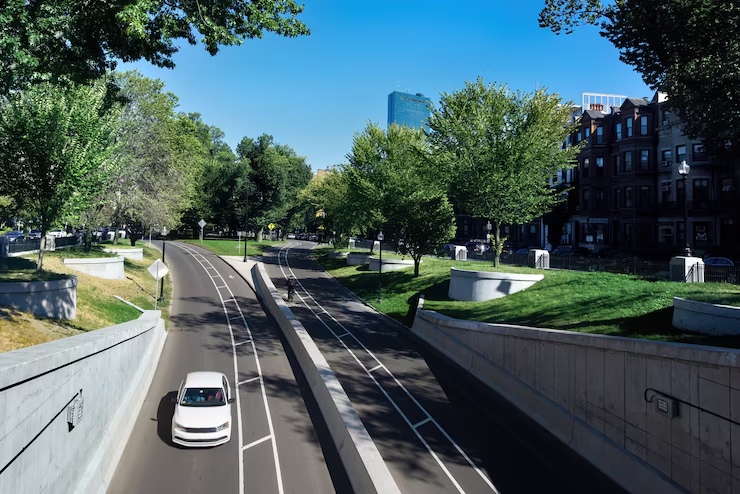Introduction
The electric vehicle (EV) revolution isn’t just transforming what we drive—it’s reshaping the very roads we drive on. From charging networks to smart highways, the shift from gasoline to electrons is triggering a rethinking of infrastructure, energy, and urban planning across the globe.This article dives into the profound changes EVs are bringing—from the plug to the pavement—and how this transformation is redefining everything from road design to policy, energy use, and mobility itself.

The Charging Network: The New Fuel Station
Gas stations used to be on every corner—but today, charging stations are beginning to rival them in visibility and importance. As EV adoption rises, countries and cities are racing to build dense, reliable, and fast charging infrastructure.
Types of EV Chargers:
Level 1 (120V) – Home outlets; slow trickle charging (~3-5 miles/hr)
Level 2 (240V) – Home or public; ~20-40 miles/hr
DC Fast Chargers (Level 3) – Up to 80% in ~20-40 minutes
Ultra-Fast Chargers – 350 kW+ systems (e.g., Ionity, Tesla V4)
Big Changes Happening Now:
Tesla opening Supercharger network to other brands
Federal and private investment in national charging corridors
Charging integrated into parking lots, apartment complexes, and streetlights
“Plug & Charge” systems for seamless payment and authentication
Smart Roads and Energy Grids: The EV-Connected Highway
EVs are more than vehicles—they’re moving batteries and data hubs, and that’s changing how roads interact with technology and energy.
Smart Road Innovations:
Vehicle-to-Infrastructure (V2I): EVs communicate with roads for traffic updates, toll payments, or weather alerts
Inductive charging: Wireless charging pads embedded in the pavement (being tested in Detroit and Europe)
Solar roads: Experimental highways that generate electricity while providing traction
Dynamic lighting: LED-lit lanes that adapt to traffic and EV data
EVs and the Energy Grid:
Vehicle-to-Grid (V2G) tech allows EVs to send power back to homes or the grid
EVs can act as energy storage during outages or peak demand
EV adoption is encouraging cities to modernize electric grids, including renewables and smart metering
Urban Planning: Cities Reimagined for Electric Mobility
EVs are quieter, cleaner, and more efficient—and that’s prompting a reevaluation of how cities are designed.
What’s Changing in Urban Spaces:
Low-Emission Zones (LEZs): Cities like London charge or restrict gas cars
Curbside charging: Stations built into sidewalks and street furniture
Multi-modal hubs: EVs integrated with bikes, scooters, and buses
Reduced noise pollution: Quieter EVs mean calmer streets and improved quality of life
Smaller parking footprints: With shared EVs and autonomy, less space is needed for parking lots
Public Transit and EVs:
Electrification of buses, delivery fleets, and taxis is reducing urban emissions
EV-friendly policies lead to denser, cleaner, pedestrian-focused city centers
Road Maintenance: Paving the Way for a New Kind of Wear and Tear
EVs have no tailpipes, but they still have weight—lots of it.
The Weight Factor:
EV batteries add hundreds of kilograms, making them heavier than gas cars
Heavier vehicles cause more wear on roads and bridges, prompting engineering updates
Solutions in Progress:
Stronger, more resilient road surfaces
Use of recycled materials and self-healing concrete
Integration of sensors in roads to monitor stress and usage in real time
Policy and Incentives: Infrastructure Driven by Law
Governments are fueling the EV surge with policy, funding, and regulation.
Global Trends:
U.S. Infrastructure Bill: $7.5B for EV chargers, $65B for clean energy grids
EU mandates: All new cars must be zero-emission by 2035
China: Massive state investment in EV factories and national charging networks
India: FAME incentives and urban EV mandates
Incentives Impacting Roads:
Zoning laws now require EV-ready parking spaces
Highway electrification for long-haul trucks
Smart toll roads that charge based on emissions or EV status
The Role of Data: EVs as Rolling Sensors
Every EV generates data—location, battery status, road conditions—which is revolutionizing how we maintain and design infrastructure.
How EV Data Helps:
Pinpoints potholes, congestion, and charging bottlenecks
Allows real-time updates to navigation and infrastructure maintenance teams
Helps utilities predict energy demand based on driving patterns
Enables cities to plan efficient, data-driven development
Environmental Impact: Cleaner Roads, Greener Planet
EVs help decarbonize transport, but their influence on infrastructure is equally important for climate goals.
Benefits of EV-Based Infrastructure:
Reduction in air and noise pollution
Support for renewable energy use
Decreased reliance on fossil-fuel-heavy maintenance (as EVs cause less mechanical wear)
Integration with climate-resilient city planning
Challenges Ahead: Not All Smooth Roads
While progress is exciting, challenges remain.
Key Issues:
Charging deserts in rural and low-income areas
Grid readiness in developing regions
Battery recycling infrastructure still underdeveloped
Need for unified charging standards and plug compatibility
Balancing privacy and surveillance from vehicle-generated data
Addressing these issues is essential to make EV-driven infrastructure inclusive and sustainable.

Conclusion:
From the plug to the pavement, electric vehicles are doing more than changing the way we drive—they’re forcing us to rethink the roads themselves. In the next decade, we’ll see highways that charge your car, cities that breathe cleaner air, and vehicles that help manage the energy grid.This isn’t just an automotive revolution—it’s an infrastructure transformation. And while the road ahead may be under construction, it’s paved with innovation, intelligence, and sustainability.Electric vehicles aren’t just changing the future of transportation—they’re rebuilding the world beneath our wheels.

